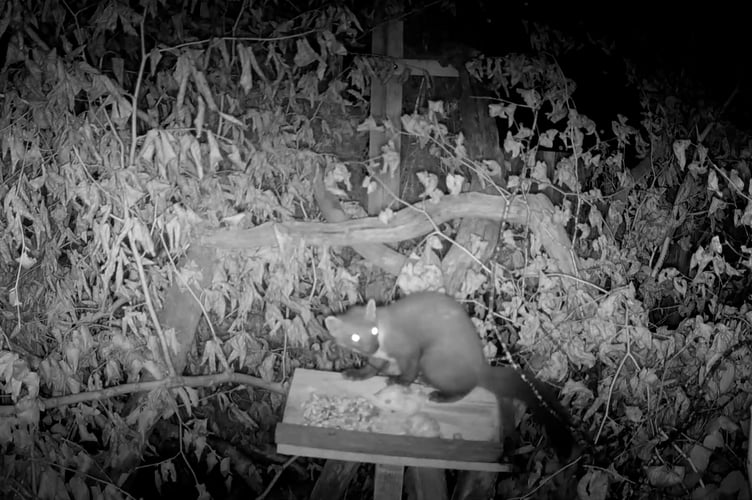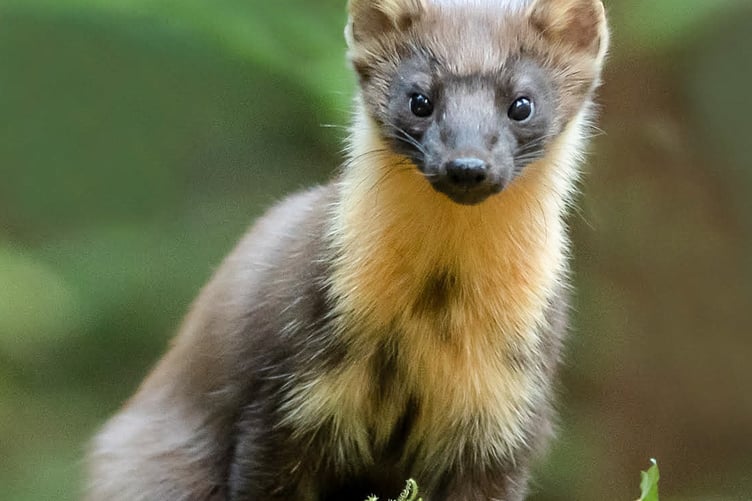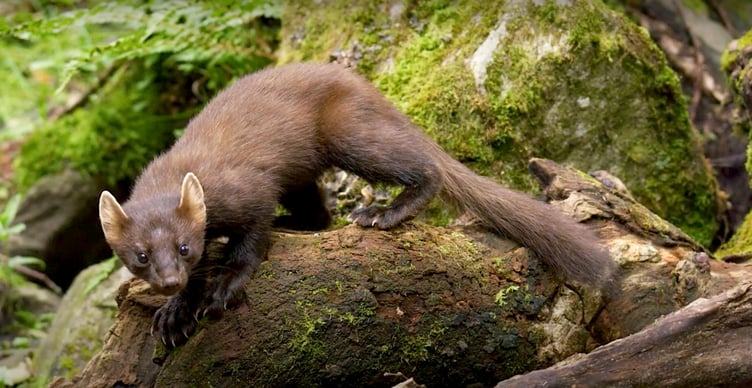CRITICALLY endangered pine martens have been reintroduced to Exmoor in a pioneering nature recovery project marking the official return of a native species lost for more than a century.
A total of 19 animals, nine females and 10 males, were secretly released last month at locations owned by the National Trust (NT) and Exmoor National Park Authority (ENPA).
The project sees the return of an animal which was once common locally, but which was lost due to hunting and the decline of its favoured woodland habitat.
Pine martens are a native species and a woodland dwelling animal the size of a small cat belonging to the weasel, or mustelid, family.
Their release is the work of the Two Moors Pine Marten Project (TMPMP) supported by The National Lottery Heritage Fund.
.jpeg?trim=0,0,0,0&width=752&height=1130&crop=752:1130)
The project is led by the charity Devon Wildlife Trust in partnership with Exmoor and Dartmoor national parks, NT, Somerset Wildlife Trust, Forestry England, and the Woodland Trust, with expert assistance from the Vincent Wildlife Trust.
The pine martens were sourced from healthy wild populations in the Scottish Highlands and the Exmoor reintroduction was licensed by both NatureScot and Natural England.
The animals died out on Exmoor in the late 1800s and although sporadic sightings have been reported in recent years, the reintroduction is the first to be planned and officially licensed.
The return of pine martens to Exmoor was timed so they could take advantage of a local abundance of wild autumn fruits.
Pine martens have a varied diet and at this time of year will consume wild fruits, along with hunting for prey which includes small mammals such as voles, mice, and grey squirrels.
It has taken seven years of planning by TMPMP working with local volunteers, stakeholders, and communities.

On arrival in Exmoor the pine martens were kept for three days in specially constructed release pens, to acclimatise quietly to their new surroundings before being allowed to leave.
Each animal has been fitted with a radio collar so it can be followed before the device drops off after six to nine months.
The Exmoor release follows the reintroduction by TMPMP on Dartmoor of 15 animals last autumn which have since become established and seen the first births of kits in July this year.
ENPA senior ecologist Ali Hawkins said: “It is just such a good news story to see pine martens back on Exmoor.
“Historical evidence shows they used to be part of our woodland landscape and reintroducing them will help bring back a natural balance that will benefit many species.”
National Trust Somerset general manager Simon Larkins said: “The return of pine martens to Exmoor is a truly special moment.
“When we first began exploring the idea of their reintroduction in 2018, we hoped one day these much-loved animals would find their way home.
“As a keystone species, pine martens play a vital role in woodland ecosystems, helping to create healthier habitats and supporting wider biodiversity.
“Their presence is a powerful reminder that when we give nature space and opportunity, recovery can happen.”
Somerset Wildlife Trust engagement officer Lucie Bennett said: “We are proud and delighted to see pine martens returning to Somerset and to have played a part in the national recovery strategy as this animal re-establishes its former range.
“At a time when wildlife needs us more than ever and action is much needed, it is fantastic to see recovery milestones met, like the return of this important mammal in functioning British woodlands.
“We look forward to monitoring the progression of the Exmoor animals, supporting woodland wildlife and local communities as the pine martens move and expand their range.”
Similar successful releases have also taken place in recent years in the Forest of Dean, Wales, and Cumbria.
The expectation is that the Dartmoor and Exmoor pine marten populations will expand gradually in coming years, eventually merging to re-establish a stable population in the Westcountry, signalling positive steps toward returning the native species to its former range.
Pine martens are solitary animals and live at low density, preferring to form territories in and around woodlands.
They are mainly nocturnal and are shy, avoiding contact with humans.
Devon Wildlife Trust’s Tracey Hamston, who leads the Two Moors Pine Marten Project said: “It is wonderful to see pine martens living wild in Exmoor again.
“These animals were once a key part of our thriving woodland wildlife, so it is good that they are back where they belong.

“It is a positive sign that nature can be restored.
“Our woodlands and their wildlife will benefit from their presence.”
National Lottery London and South director Stuart McLeod said: “This is a landmark moment, witnessing the return of pine martens to Exmoor after more than a century is truly inspiring.
“Thanks to National Lottery players, we are helping to restore a native species to the landscapes it once called home.
“Reintroducing lost wildlife is essential for building resilient ecosystems and driving nature’s recovery.
“This project is a powerful example of what can be achieved when organisations unite with a shared vision.”
The Exmoor reintroduction saw a huge concerted effort by TMPMP and its local volunteers.
Key tasks included:
- Surveying dozens of sites to determine where best to release pine martens
- Working with landowners, commercial shoot owners, and farmers
- Constructing release pens, monitoring the new arrivals, and supplying them with food and water
As well as continuing to track progress of pine martens released on Exmoor and Dartmoor, the TMPMP’s aim is to engage hundreds of people from a wide range of communities across the Westcountry over the next two years.
Opportunities to become involved with the project include:
- People of all ages and backgrounds can become citizen scientists and nature spotters monitoring pine marten behaviour and other woodland wildlife
- Woodland-themed, nature-based activities and events in communities local to pine marten release sites
- Small grants for community-based projects which will help nurture local woodland wildlife
- A free digital download pack focussed on pine martens and woodlands, containing wildlife spotter sheets, self-guided discovery trails and craft activities
- Advice to woodland owners on how to manage their woodland to support a range of wildlife which will include enhancing habitat for pine martens
Forestry England forest planner Abigail Parravani said: “This release is a thrilling moment for Exmoor and a watershed moment for the pine marten in the South West.

“It is so exciting to support a project that is helping nature recovery by bringing back a native species and we cannot wait to see this population establishing in the landscape.”
Woodland Trust assistant site manager Jack Hunt said: “Following the extensive surveying, planning and preparation required for the Dartmoor release, it has been an amazing experience tracking the pine martens and getting to know them over the course of their first year here in Devon.
“Seeing the kits on camera was a huge highlight.
“The Exmoor release is a chance to build on what we have learnt over the last year and establish a stable and healthy population of this missing species in the South West.”
Anybody interested in finding out more about pine martens and the Two Moors Pine Marten Project should visit the project’s website.




Comments
This article has no comments yet. Be the first to leave a comment.